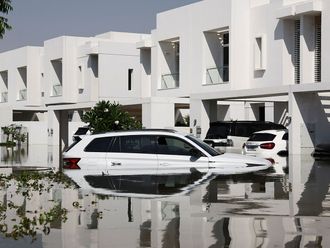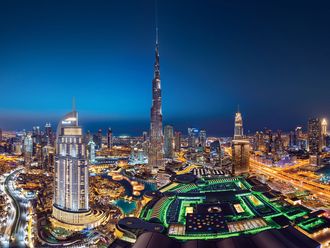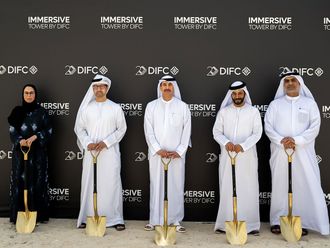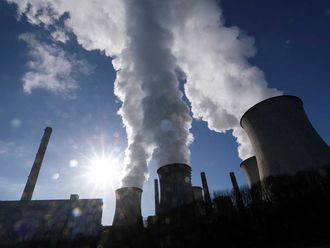
T urning on to 13th Street, off Zabeel Road, the blazing stock ticker on your left and The Gate towering behind it are the first signs that you've arrived at the Dubai International Financial Centre (DIFC), the city's financial nucleus.
DIFC was the first financial free zone in the region, attracting and registering over 850 companies in five years. Opened in 2004, the seeds for the centre were sewn in a 1999 report commissioned by His Highness Shaikh Mohammad Bin Rashid Al Maktoum, Vice President and Prime Minister of the UAE and Ruler of Dubai, in his then capacity as Crown Prince.
Rather than remaining content with Dubai's rapid growth, the report cautioned against over-reliance on the oil and gas sector. By 2002, the plan for a new global financial services hub was completed by the Dubai government and the centre opened just two years later.
The DIFC concept stimulated rapid growth that allowed the centre to command premium commercial rents that, according to a recent CB Richard Ellis report, were by Q4 2009 the second highest in Europe, Middle East and Africa, at about Dh3,981 per square metre per annum.
Just as DIFC's place in a network of global financial hubs has afforded it success, it also makes it vulnerable to the whims of the global market and, according to the same report, DIFC lost 27.3 per cent of its value over the previous 12 months.
In the report, Matthew Green, head of research UAE, at CBRE Middle East, says, "Rents within the DIFC free zone have seen a level of protection during the downturn; however, we are now starting to see some movement in negotiation levels within both DIFCA [DIFC Authority] and privately managed buildings. The local market environment will continue to face new challenges during 2010 and this is sure to create additional cost implications for occupiers, especially those in prime locations such as the DIFC."
Speaking at a recent press conference, DIFC's CEO Abdulla Al Awar cautioned attendees not to categorise the centre as a traditional commercial property venue, pointing to its unique infrastructure, which includes regulatory and judicial branches. "We are not just real estate… One has to always think with a holistic approach. Are we utilising only the office building or are we utilising the whole system?"
Meanwhile, against the backdrop of the CBRE report, the area's first batch of residential projects are still relatively new to the market and, given the intended synergy between DIFC's residential and commercial spheres, both are well worth examining.
Skygardens
While Dubai enjoys temperate weather for many months, for part of the year heat forces residents indoors.
In fact, Dubai's fondness for indoor environments is part of the inspiration behind Skygardens, which represents London-based architectural firm Gensler's aim to bring the outdoors inside in the form of five gardens spread across the building's 47 levels.
"It's based on the concept of ‘living reinvented'," says Michael Michael, director of sales and leasing at Landmark Properties, one of the rental agents for the development. "The building is placing multiple gardens in the sky. There is also a rooftop garden surrounded by penthouses."
However, bringing nature indoors isn't the only strategy behind this building, which was erected with financial district professionals in mind. "The tower is ideal for DIFC employees. They don't need to worry about petrol prices or parking," says Michael. "The ease of walking across the street to work has attracted many residents, as well as helped many DIFC companies to house their incoming staff. With its recent lease promotions, Skygardens is quite affordable for the surrounding area, so other professionals who are looking for high quality living... can also consider it."
Built by Arabtec under the supervision of WS Atkins, Skygardens is centrally located at the entrance of DIFC, just a few minutes from Shaikh Zayed Road and Downtown Burj Khalifa. Michael says it's also great for frequent fliers as "the airport is about a 15-minute drive away".
The building's amenities include a rooftop swimming pool, a fitness centre and sauna, outdoor entertainment area, children's play area, high-speed lifts, an underground car park and 24-hour security.
Sale prices start from Dh1,550-1,600 per square foot, comparable to upper limit sales in Dubai Marina and most of Downtown Burj Khalifa, according to Landmark Advisory's April sales report. Like elsewhere in Dubai, rents have dropped at Skygardens in recent months. Unfurnished units range from Dh53,200 base price for a studio to Dh68,400 for a one-bedroom and Dh91,200 for a two-bedroom. Quarter-on-quarter, rents for one-bedroom units in DIFC declined by 4.7 per cent, according to Landmark's report, a drop compatible to that of one-bedrooms in Downtown Burj Khalifa.
You'll pay more for the best views at Skygardens, but even if you're not a DIFC number cruncher, it represents reasonable value, given its location.
Liberty House
With its L-shaped footprint, Liberty House's name seems appropriate in a free zone. Mohammad Ali, general manager, ETA Star Properties says the building "gives you the freedom to work and live". Completed at the end of 2008, the 42-storey mixed-use tower consists of ten floors of high-end offices, 20 levels of residential apartments and six floors of parking. Most offices are located around a central atrium, which provides natural light. Apartments all have balconies and terraces. The complex also features a gymnasium, swimming pool, a restaurant and an art cafe. Furnished units feature Belgian and Italian furniture, which give the apartments "a contemporary yet sophisticated look", says Ali.
Rents start from Dh65,000 for a studio, Dh90,000 for a one-bedroom and Dh140,000 for a two-bedroom. Given its location, this is competitively priced for furnished apartments.
Liberty House is within walking distance of the Financial Centre Metro Station, DIFC Gate District and the shops and eateries along Shaikh Zayed Road. The building has two relaxation decks — both with pools. ETA Star is currently building a second gym and is considering adding a sauna, steam room, Jacuzzi, and fitness suite, as well as a rooftop jogging track. The building was launched in 2004 as a joint venture between ETA Star Properties and DIFC. Now fully operated by ETA Star, most of the units were sold off-plan. As Ali recounts, the development did well at launch: "You can say we were successful, [having sold] 80 per cent of the project during the launch phase itself. However, we are helping with leasing apartments now and DIFC companies are definitely the target group."
The drawcard is Liberty House's proximity to DIFC, which itself capitalises on the fact that it's equidistant from the financial centres of Europe and Asia.
Ali says, "DIFC also offers a highly attractive investment environment [with its] zero rate tax, freehold ownership and the ability to repatriate capital."
In terms of sales prices, apartments in DIFC range from Dh1,400-2,000 per square foot, according to Landmark's April sales guide. This compares to Dh1,500-2,000 on Old Town Island, Burj Downtown, Dh700-1,450 in Dubai Marina or Dh750-1,700 on Palm Jumeirah. This puts DIFC up there with Dubai's priciest apartments, aside from Burj Khalifa (Dh3,400-4,500).
Interestingly, DIFC's residential prices remain similar to those recorded in Landmark's November-December 2009 sales guide: one-bedrooms ranging from Dh1,400-2,000 and two-bedrooms Dh1,400-1,900 per square foot, indicating that developers and/or landlords are reluctant to budge. With few transaction in the Dubai market, developers and agents are pitching leasing. And while rents may not match the lofty heights of DIFC's office spaces, the softened rates may tempt some DIFC professionals and corporates.
Liam Nelson is a












